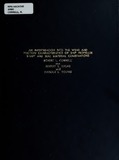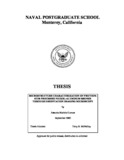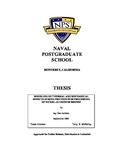An investigation into the wear and friction characteristics of ship propeller shaft and sea material combinations
| dc.contributor.advisor | Rightmire, Brandon G. | |
| dc.contributor.author | Cornell, Robert L. | |
| dc.contributor.author | Lucas, Robert S. | |
| dc.contributor.author | Young, Harold L. | |
| dc.date | May 1960 | |
| dc.date.accessioned | 2012-08-29T23:32:21Z | |
| dc.date.available | 2012-08-29T23:32:21Z | |
| dc.date.issued | 1960-05 | |
| dc.identifier.uri | https://hdl.handle.net/10945/12387 | |
| dc.description | This thesis document was issued under the authority of another institution, not NPS. At the time it was written, a copy was added to the NPS Library collection for reasons not now known. It has been included in the digital archive for its historical value to NPS. Not believed to be a CIVINS (Civilian Institutions) title. | en_US |
| dc.description.abstract | The unsatisfactory wear properties of various seal and propeller shaft material combinations on many of our submarines, particularly those of the deep-submergence class and those where the trend is towards the larger shaft diameters, prompted this investigation. While the fault may well lay in design, this paper approaches the problem as one in boundary lubrication; attempting to find the best combination of seal material and mating service in this particular service condition from a wear viewpoint. An additional aim was to attempt some correlation between wear, friction, and the physical properties involved. Results from this latter goal could well find application in the selection of steam turbine seals as well as those employed in the aircraft industry. The approach used by the authors was first to evaluate potential seal materials from different families in combination with various corrosion-resistant shaft materials. This work was done on the Kinetic Oiliness Testing Machine (KOTM) and the results are presented in Part I of this investigation. The testing involved obtaining friction and wear data on carbons and laminated phenolics, as well as teflon, in combination with chrome, bronze G, and stellite #6„ Synthetic sea water was the primary lubricant, although the effect of wetting agents was also checked. Results here conclusively demonstrated the superiority of commercial grade carbon seals, for the wear of the laminated phenolics was excessive, and transition temperature effects were experienced with the straight teflon samples at roughly 250°F ambient temperature. While successful as a screening tool, the KOTM proved inadequate for wear measurements of carbons; and for this reason the pin on disc geometric configuration was utilized in Part II. This section involved a more extensive analysis of the friction and wear properties of carbons in combination with five potential shaft materials. Twenty-one commercial grade carbons in all were tested, the number representing a wide cross section in graphite content 8 hardness 9 impregnation and other physical properties. The effect of wetting agents, up to 50$ by volume, are also presented. Results of this phase conclusively demonstrated the superiority of chrome as a mating surface for carbon, its high heat of reaction and resultant resistance to carbide formation giving reasonably low friction and wear values. Several carbons were grouped close to the top when all were compared from a wear and friction viewpoint, but one, Carbon 1, was shown to be the superior material of those tested in this boundary lubrication problem. The effect of wetting agents contradicted our original assumption, in that concentrations up to 50$ by volume gave higher frictional values than that experienced with synthetic sea water. | en_US |
| dc.description.uri | http://archive.org/details/aninvestigationi1094512387 | |
| dc.language.iso | en_US | |
| dc.publisher | Massachusetts Institute of Technology | en_US |
| dc.rights | This publication is a work of the U.S. Government as defined in Title 17, United States Code, Section 101. Copyright protection is not available for this work in the United States. | en_US |
| dc.subject.lcsh | Mechanical engineering | en_US |
| dc.title | An investigation into the wear and friction characteristics of ship propeller shaft and sea material combinations | en_US |
| dc.type | Thesis | en_US |
| dc.contributor.department | Naval Architecture and Marine Engineering | |
| dc.description.service | Lieutenant, United States Navy | en_US |
| dc.description.service | Lieutenant, United States Coast Guard | en_US |
| etd.thesisdegree.name | M.S. in Naval Architecture and Marine Engineering | en_US |
| etd.thesisdegree.name | Degree of Naval Engineer | en_US |
| etd.thesisdegree.level | Masters | en_US |
| etd.thesisdegree.discipline | Naval Architecture and Marine Engineering | en_US |
| etd.thesisdegree.grantor | Massachusetts Institute of Technology | en_US |
Files in this item
This item appears in the following Collection(s)
-
1. Thesis and Dissertation Collection, all items
Publicly releasable NPS Theses, Dissertations, MBA Professional Reports, Joint Applied Projects, Systems Engineering Project Reports and other NPS degree-earning written works.





